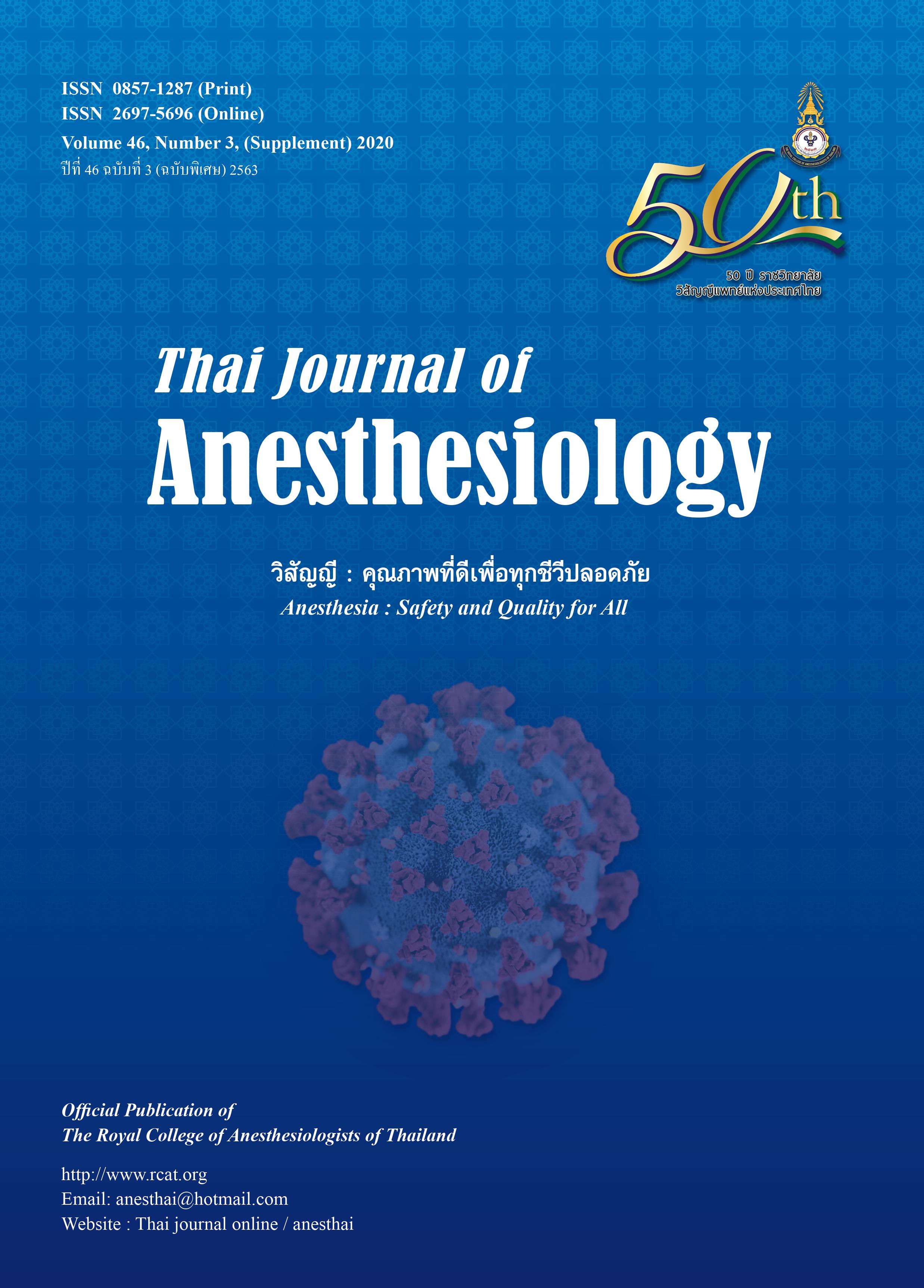An Innovative Design of Siriraj Collapsible Paper Box Set for Electroconvulsive Therapy in Psychiatric Patients during COVID-19 Outbreak
Main Article Content
Abstract
As a result of the Coronavirus disease-2019
pandemic, there have been strict screening measures for
patients scheduled for operations or procedures that
require anesthesia. Personal protective equipment is
essential to narrow the chance of transmission of the virus
to medical personnel. Other protective barriers which
reduce direct viral transmission to the atmosphere can
potentially limit the infection rate. This article discusses
about the innovation called “Siriraj collapsible paper box
set”. The box is supposed to cover the patients during
Electroconvulsive therapy to diminish the spreading of
droplets or aerosols during anesthesia.
Article Details
Section
Original articles
References
1. Coronavirus disease (COVID-2019) situation reports. World
Health Organization. 2020 [cited 2020 May 23]. Available
from: https://www.who.int/emergencies/diseases/novelcoronavirus-
2019/situation-reports/
2. Zucco L, Levy N, Ketchandji D, Aziz M, Ramachandran SK.
Perioperative considerations for the 2019 Novel Coronavirus
(COVID-19). Anesthesia Patient Safety Foundation. 2020 [cite
2020 Apr 28]. Available from: https://www.apsf.org/newsupdates/
perioperative-considerations-for-the-2019-novelcoronavirus-
covid-19/
3. UPDATE: The use of personal protective equipment by
anesthesia professionals during the COVID-19 pandemic.
American Society of Anesthesiologists. 2020 [cited May 23].
Available from: https://www.asahq.org/about-asa/newsroom/
news-releases/2020/03/update-the-use-of-personalprotective-
equipment-by-anesthesia-professionals-duringthe-
covid-19-pandemic
4. Gournellis R, Tournikioti K, Touloumi G, et al. Psychotic
(delusional) depression and completed suicide: a systematic
review and meta-analysis. Ann Gen Psychiatry 2018;17:39.
5. Tor PC, Phu AHH, Koh DSH, Mok YM. ECT in a time of
COVID-19. J ECT 2020;doi 10.1097/YCT.0000000000000690.
6. Ruffalo ML. During COVID-19 some hospitals stop ECT
treatment: Psychology Today. 2020 [cited Apr 28]. Available
from: https://www.psychologytoday.com/us/blog/freudfluoxetine/
202004/during-covid-19-some-hospitals-stop-ecttreatment
7. Laosuwan P, Earsakul A, Pannangpetch P, Sereeyotin J.
Acrylic box vs. plastic sheet covering on droplet dispersal
during extubation in COVID-19 patients. Anesth Analg
2020;doi: 10.1213/ANE.0000000000004937.
8. van Doremalen N, Bushmaker T, Morris DH, et al. Aerosol
and surface stability of SARS-CoV-2 as compared with SARSCoV-
1. N Engl J Med 2020;382:1564-67.
9. Kampf G, Todt D, Pfaender S, Steinmann E. Persistence of
coronaviruses on inanimate surfaces and their inactivation
with biocidal agents. J Hosp Infect 2020;104:246-51.
10. Hoyer C, Kranaster L, Janke C, Sartorius A. Impact of the
anesthetic agents ketamine, etomidate, thiopental, and
propofol on seizure parameters and seizure quality in
electroconvulsive therapy: a retrospective study. Eur Arch
Psychiatry Clin Neurosci 2014;264:255-61.
11. Nishikawa K, Yamakage M. Effects of the concurrent use of
a reduced dose of propofol with divided supplemental
remifentanil and moderate hyperventilation on duration and
morphology of electroconvulsive therapy-induced
electroencephalographic seizure activity: A randomized
controlled trial. J Clin Anesth 2017;37:63-8.
12. Bryson EO, Kellner CH, Li EH, Aloysi AS, Majeske M. Extreme
variability in succinylcholine dose for muscle relaxation in
electroconvulsive therapy. Australas Psychiatry 2018;26:
391-3.
Health Organization. 2020 [cited 2020 May 23]. Available
from: https://www.who.int/emergencies/diseases/novelcoronavirus-
2019/situation-reports/
2. Zucco L, Levy N, Ketchandji D, Aziz M, Ramachandran SK.
Perioperative considerations for the 2019 Novel Coronavirus
(COVID-19). Anesthesia Patient Safety Foundation. 2020 [cite
2020 Apr 28]. Available from: https://www.apsf.org/newsupdates/
perioperative-considerations-for-the-2019-novelcoronavirus-
covid-19/
3. UPDATE: The use of personal protective equipment by
anesthesia professionals during the COVID-19 pandemic.
American Society of Anesthesiologists. 2020 [cited May 23].
Available from: https://www.asahq.org/about-asa/newsroom/
news-releases/2020/03/update-the-use-of-personalprotective-
equipment-by-anesthesia-professionals-duringthe-
covid-19-pandemic
4. Gournellis R, Tournikioti K, Touloumi G, et al. Psychotic
(delusional) depression and completed suicide: a systematic
review and meta-analysis. Ann Gen Psychiatry 2018;17:39.
5. Tor PC, Phu AHH, Koh DSH, Mok YM. ECT in a time of
COVID-19. J ECT 2020;doi 10.1097/YCT.0000000000000690.
6. Ruffalo ML. During COVID-19 some hospitals stop ECT
treatment: Psychology Today. 2020 [cited Apr 28]. Available
from: https://www.psychologytoday.com/us/blog/freudfluoxetine/
202004/during-covid-19-some-hospitals-stop-ecttreatment
7. Laosuwan P, Earsakul A, Pannangpetch P, Sereeyotin J.
Acrylic box vs. plastic sheet covering on droplet dispersal
during extubation in COVID-19 patients. Anesth Analg
2020;doi: 10.1213/ANE.0000000000004937.
8. van Doremalen N, Bushmaker T, Morris DH, et al. Aerosol
and surface stability of SARS-CoV-2 as compared with SARSCoV-
1. N Engl J Med 2020;382:1564-67.
9. Kampf G, Todt D, Pfaender S, Steinmann E. Persistence of
coronaviruses on inanimate surfaces and their inactivation
with biocidal agents. J Hosp Infect 2020;104:246-51.
10. Hoyer C, Kranaster L, Janke C, Sartorius A. Impact of the
anesthetic agents ketamine, etomidate, thiopental, and
propofol on seizure parameters and seizure quality in
electroconvulsive therapy: a retrospective study. Eur Arch
Psychiatry Clin Neurosci 2014;264:255-61.
11. Nishikawa K, Yamakage M. Effects of the concurrent use of
a reduced dose of propofol with divided supplemental
remifentanil and moderate hyperventilation on duration and
morphology of electroconvulsive therapy-induced
electroencephalographic seizure activity: A randomized
controlled trial. J Clin Anesth 2017;37:63-8.
12. Bryson EO, Kellner CH, Li EH, Aloysi AS, Majeske M. Extreme
variability in succinylcholine dose for muscle relaxation in
electroconvulsive therapy. Australas Psychiatry 2018;26:
391-3.


